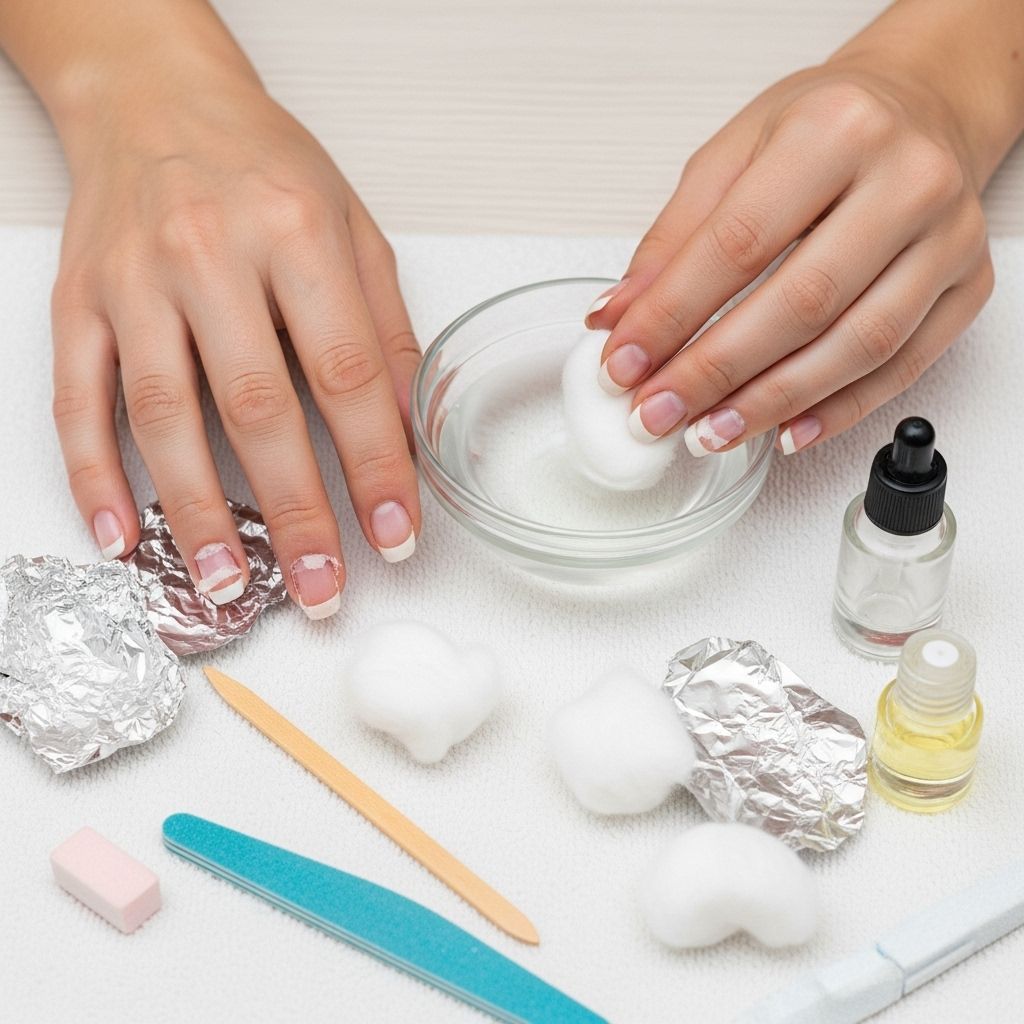How to Remove Acrylic Nails Safely at Home Without Damage
Expert-approved steps to safely remove acrylic nails and protect your natural nails from damage

Introduction
Acrylic nails offer durability and style, but their removal requires care to avoid damaging your natural nails. Whether you’re a salon regular or a DIY enthusiast, understanding the safest removal process is crucial. This guide covers both acetone-based and acetone-free removal methods, expert tips, and aftercare to keep your nails healthy.
Why Proper Acrylic Removal Matters
Improper removal can lead to peeling, breakage, and even infections. Ripping off acrylics or using harsh tools can strip layers from your natural nail, causing long-term damage. The key is patience and the right technique.
How to Remove Acrylic Nails at Home: The Basics
While salon removal is often safest, you can remove acrylic nails at home with the correct tools and precautions. The most common method uses pure acetone to dissolve the acrylic, but there are alternatives for those who want to avoid acetone entirely.
Step-by-Step: Removing Acrylic Nails With Acetone
Step 1: Prepare Your Nails
- Trim acrylic nails as short as possible using nail clippers.
- Lightly buff the surface with a nail file to remove the shiny topcoat. This helps the acetone penetrate more effectively.
Step 2: Protect the Surrounding Skin
- Apply petroleum jelly (like Vaseline) to the skin around your nails to protect it from the drying effects of acetone.
Step 3: Soak Cotton Balls or Pads
- Soak cotton balls or pads in 100% pure acetone until fully saturated, but not dripping.
Step 4: Apply Acetone to Nails
- Place an acetone-soaked cotton pad on each nail.
- Wrap each fingertip with aluminum foil or use nail clips to hold the cotton in place.
Step 5: Wait and Check
- Let your nails soak for 20–30 minutes. If the acrylic hasn’t softened, rewrap and wait longer.
Step 6: Remove and Gently Scrape
- After soaking, gently push off the softened acrylic with a cuticle pusher or orange stick. Never force it—if it resists, soak a bit longer.
Step 7: Buff and Moisturize
- Buff away any remaining acrylic gently.
- Wash your hands, then apply cuticle oil and a hydrating hand cream to restore moisture.
How to Remove Acrylic Nails Without Acetone
If you prefer not to use acetone, you can remove acrylics using an electric nail file (e-file), but this should be done with extreme care to avoid damaging your natural nails.
Step-by-Step: Acetone-Free Removal With an E-File
- Safely sand down the acrylic: Use a sanding bit to gently remove the top layer of acrylic. Stop before reaching your natural nail.
- Preparation is crucial: If you’re inexperienced, watch tutorials and proceed with caution. Improper use can cause significant nail damage.
Step-by-Step: Soaking Off Without a Tray
- Cut off excess acrylic: Clip your nails as short as possible.
- Use a plastic bag: Pour acetone into a resealable plastic bag, submerge your nails, and let them soak for 15–20 minutes.
- Gently scrape off acrylic: Use a wooden stick to remove softened acrylic. Buff and moisturize after.
What Not to Do When Removing Acrylic Nails
- Don’t rip off your acrylics: This can pull layers of your natural nail off, leading to pain and damage.
- Avoid using metal tools aggressively: They can scratch or gouge your nail bed.
- Don’t skip moisturizing: Acetone is extremely drying. Apply cuticle oil and hand cream after removal.
Aftercare for Your Natural Nails
Post-removal, your nails need extra attention. Use a nail strengthener if needed, keep them hydrated, and avoid harsh chemicals or excessive filing until they recover.
Professional vs. At-Home Removal
| Method | Pros | Cons |
|---|---|---|
| Professional | Fast, safe, minimal risk of damage | Costly, requires appointment |
| At-home (acetone) | Convenient, cost-effective | Risk of over-soaking, drying out nails and skin |
| At-home (e-file) | Quick, acetone-free | High risk of injury if done improperly |
Common Mistakes to Avoid
- Using nail glue remover instead of pure acetone (ineffective and potentially harmful)
- Skipping the buffing step, which prevents the acetone from working efficiently
- Not protecting your skin from acetone, leading to dryness and irritation
- Forcing acrylic off before it’s fully softened, risking nail plate injury
When to See a Professional
If you experience pain, redness, or signs of infection, stop immediately and consult a professional. Those with brittle, damaged, or sensitive nails should also consider salon removal.
Frequently Asked Questions (FAQs)
Can I reuse acrylic nails?
No, acrylic nails should not be reused. Each set is custom-shaped to your natural nail, and reusing them increases the risk of infections and improper fit.
How long does it take to remove acrylic nails with acetone?
It typically takes 20–30 minutes, but thicker acrylics may require longer soaking. Always check gently before scraping.
What if the acrylic won’t come off?
Resoak for a few more minutes, but don’t force it. If you’re struggling, consult a professional to avoid damage.
Can I use regular nail polish remover instead of acetone?
No, most regular removers aren’t strong enough. You need pure, 100% acetone for effective acrylic removal.
Will my nails be weak after removal?
Your nails may feel thin or weak temporarily. Proper hydration and care will help them recover over time.
Essential Tools and Products
- 100% Pure Acetone
- Cotton balls or pads
- Aluminum foil or nail clips
- Cuticle pusher or orange stick
- Nail file or buffer
- Cuticle oil and hydrating hand cream
Conclusion
Removing acrylic nails safely at home is possible with patience, the right products, and gentle techniques. Always prioritize nail health over speed, and don’t hesitate to seek professional help if you encounter difficulties. With proper aftercare, your natural nails can recover and stay strong.
References
- https://www.cosmopolitanme.com/beauty/how-to-remove-acrylic-nails
- https://www.cosmopolitan.com/uk/beauty-hair/nails/a27029301/acrylic-nails/
- https://www.cosmopolitan.com/style-beauty/beauty/a29668760/how-to-remove-acrylic-nails/
- https://www.youtube.com/watch?v=Rc8Ce1RRYmM
- https://www.youtube.com/shorts/S4DV4i6Xxsg
Read full bio of medha deb












